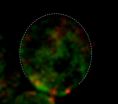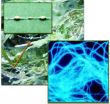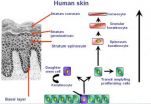(Press-News.org) A collaborative research team including a Medical College of Wisconsin (MCW) pediatric neuropathologist successfully mitigated some of the effects of a muscular disease by using a new targeted enzyme replacement therapy strategy from 4s3 Bioscience.
The findings are published in the January edition of Human and Molecular Genetics http://hmg.oxfordjournals.org/content/early/2013/01/09/hmg.ddt003.full.pdf+html.
X-linked myotubular myopathy (XLMTM) is a severe muscle disease caused by an absence of a protein called myotubularin. There is currently no treatment for this disorder, and most patients die in infancy or childhood. The overall incidence of myotubular myopathy is 1 in 50,000 live male births.
Michael W. Lawlor, M.D., Ph.D., assistant professor of pathology at MCW, researcher at the Children's Hospital of Wisconsin Research Institute, and director of the pediatric pathology neuromuscular laboratory in MCW's division of pediatric pathology, coordinated a study at Boston Children's Hospital and MCW that used targeted enzyme replacement therapy to deliver myotubularin to muscles of mice with XLMTM. After two weeks of treatment, the mice showed marked improvement in muscle function and pathology.
"These promising findings suggest that even low levels of myotubularin protein replacement can not only improve weakness in patients, but also at least partially reverse the structural abnormalities seen in XLMTM," said Dr. Lawlor. "The next step is to determine appropriate dosage, and toxicity, before we venture into human trials," he continued.
### The study was supported by the National Institutes of Health, the Muscular Dystrophy Association, the Joshua Frase Foundation, and the Lee and Penny Anderson Family Foundation.
Co-authors of the study are Dustin Armstrong and Michael O'Callaghan from 4s3 Bioscience, Inc.; Marissa Viola, Cynthia P. Hsu, and Alan H. Beggs from Boston Children's Hospital and Harvard Medical School; Jeffrey J. Widrick from Spaulding Rehabilitation Hospital; Hui Meng from MCW; Robert W. Grange from Virginia Tech; Martin Childers from Wake Forest University; Christopher R. Pierson from Nationwide Children's Hospital; and Anna Buj-Bello from INSERM.
The efforts of Drs. Armstrong, Beggs, and Lawlor began while Dr. Lawlor was working for Dr. Beggs at Boston Children's Hospital, and this collaborative effort has continued at Dr. Lawlor's lab at MCW. As studies progress, Dr. Lawlor will continue to perform pathological analyses on research tissue from preclinical studies with the 4s3 Bioscience replacement enzyme and assist in further elucidating the pathophysiology of XLMTM. This work by Dr. Lawlor's laboratory utilizes resources partially supported and available through the Children's Research Institute's Imaging Core Facility.
About the Medical College of Wisconsin
The Medical College of Wisconsin is the state's only private medical school and health sciences graduate school. Founded in 1893, it is dedicated to leadership and excellence in education, patient care, research and service. More than 1,200 students are enrolled in the Medical College's medical school and graduate school programs. A major national research center, it is the largest research institution in the Milwaukee metro area and second largest in Wisconsin. In FY 2010 – 11, faculty received more than $175 million in external support for research, teaching, training and related purposes, of which more than $161 million is for research. This total includes highly competitive research and training awards from the National Institutes of Health (NIH). Annually, College faculty direct or collaborate on more than 2,200 research studies, including clinical trials. Additionally, more than 1,350 physicians provide care in virtually every specialty of medicine for more than 400,000 patients annually.
About Children's Hospital of Wisconsin
Children's Hospital of Wisconsin is the region's only independent health care system dedicated solely to the health and well-being of children. The hospital, with locations in Milwaukee and Neenah, Wis. is recognized as one of the leading pediatric health care centers in the United States. Children's Hospital provides primary care, specialty care, urgent care, emergency care, community health services, foster and adoption services, child and family counseling, child advocacy services and family resource centers. In 2011, Children's Hospital invested more than $100 million in the community to improve the health status of children through medical care, advocacy, education and pediatric medical research. Children's Hospital achieves its mission in part through donations from individuals, corporations and foundations and is proud to be a Children's Miracle Network Hospital. For more information, visit the website at chw.org.
About Children's Hospital of Wisconsin's Research Institute
Children's Research Institute is the only entity of its kind in the region advancing pediatric medical research for children in Wisconsin and beyond and is a member of Children's Hospital of Wisconsin, the region's only independent health care system dedicated solely to the health and well-being of children. The hospital, with locations in Milwaukee and Neenah, Wis. is recognized as one of the leading pediatric health care centers in the United States. Children's Hospital provides primary care, specialty care, urgent care, emergency care, community health services, foster and adoption services, child and family counseling, child advocacy services and family resource centers. In 2011, Children's Hospital invested more than $100 million in the community to improve the health status of children through medical care, advocacy, education and pediatric medical research. Children's Hospital achieves its mission in part through donations from individuals, corporations and foundations and is proud to be a Children's Miracle Network Hospital. For more information, visit the website at chw.org.
Enzyme replacement therapy shows promising results in X-linked myotubular myopathy
2013-01-22
ELSE PRESS RELEASES FROM THIS DATE:
New 2D material for next generation high-speed electronics
2013-01-22
Scientists at CSIRO and RMIT University have produced a new two-dimensional material that could revolutionise the electronics market, making "nano" more than just a marketing term.
The material – made up of layers of crystal known as molybdenum oxides – has unique properties that encourage the free flow of electrons at ultra-high speeds.
In a paper published in the January issue of materials science journal Advanced Materials, the researchers explain how they adapted a revolutionary material known as graphene to create a new conductive nano-material.
Graphene was ...
Study of how eye cells become damaged could help prevent blindness
2013-01-22
Light-sensing cells in the eye rely on their outer segment to convert light into neural signals that allow us to see. But because of its unique cylindrical shape, the outer segment is prone to breakage, which can cause blindness in humans. A study published by Cell Press on January 22nd in the Biophysical Journal provides new insight into the mechanical properties that cause the outer segment to snap under pressure. The new experimental and theoretical findings help to explain the origin of severe eye diseases and could lead to new ways of preventing blindness.
...
Controlling spine metastases with tumor 'separation surgery' and high-dose stereotactic radiosurgery
2013-01-22
Charlottesville, VA (January 22, 2013). Researchers from Memorial Sloan-Kettering Cancer Center (New York, NY) have found that tumor "separation surgery" followed by high-dose hypofractionated stereotactic radiosurgery (SRS) or high-dose single-fraction SRS is safe and effective in controlling spinal metastases regardless of the radiosensitivity of the particular tumor type that has invaded the spine. This finding is fleshed out in the article "Local disease control for spinal metastases following 'separation surgery' and adjuvant hypofractionated or high-dose single-fraction ...
Evidence mounts for role of mutated genes in development of schizophrenia
2013-01-22
Johns Hopkins researchers have identified a rare gene mutation in a single family with a high rate of schizophrenia, adding to evidence that abnormal genes play a role in the development of the disease.
The researchers, in a report published in the journal Molecular Psychiatry, say that family members with the mutation in the gene Neuronal PAS domain protein 3 (NPAS3) appear at high risk of developing schizophrenia or another debilitating mental illnesses.
Normally functioning NPAS3 regulates the development of healthy neurons, especially in a region of the brain known ...
A diffusion trap
2013-01-22
KANSAS CITY, MO – Over the past several years, Rong Li, Ph.D., at the Stowers Institute for Medical Research has been making crucial discoveries about the development of cell polarity—the process by which one side of a cell becomes different from the other side. Such polarity is critical for the functioning of the vast majority of cells. The outside surface of skin cells is very different from the surface inside the body, for example, while nerve cells have delicately branching dendrites on one end and axons on the other. Li's lab studies yeast cells, which form a unique ...
Synchrotron infrared unveils a mysterious microbial community
2013-01-22
In the fall of 2010, Hoi-Ying Holman of the U.S. Department of Energy's Lawrence Berkeley National Laboratory (Berkeley Lab) was approached by an international team researching a mysterious microbial community discovered deep in cold sulfur springs in southern Germany.
"They told me what they were doing and said, 'We know what you contributed to the oil-spill research,'" recalls Holman, who heads the Chemical Ecology group in Berkeley Lab's Earth Sciences Division. "They wondered if I could help them determine the biochemistry of their microbe samples."
Holman had ...
Immune cells engineered in lab to resist HIV infection, Stanford study shows
2013-01-22
STANFORD, Calif. — Researchers at the Stanford University School of Medicine have found a novel way to engineer key cells of the immune system so they remain resistant to infection with HIV, the virus that causes AIDS.
A new study describes the use of a kind of molecular scissors to cut and paste a series of HIV-resistant genes into T cells, specialized immune cells targeted by the AIDS virus. The genome editing was made in a gene that the virus uses to gain entry into the cell. By inactivating a receptor gene and inserting additional anti-HIV genes, the virus was blocked ...
Sex of early birds suggests dinosaur reproductive style
2013-01-22
In a paper published in Nature Communications on January 22, 2013, a team of paleontologists including Dr. Luis Chiappe, Director of the Natural History Museum of Los Angeles County's (NHM) Dinosaur Institute, has discovered a way to determine the sex of an avian dinosaur species.
Confuciusornis sanctus, a 125-million-year-old Mesozoic bird, had remarkable differences in plumage — some had long, almost body length ornamental tail feathers, others had none — features that have been interpreted as the earliest example of avian courtship. However, the idea that male Confuciusornis ...
The skin aging regulator
2013-01-22
These mechanisms, described in vivo in mice, engage molecule CD98hc, which is involved in epidermis renewal and could be an indicator of the skin's capacity for regeneration.
The results were published in the Journal of Experimental Medicine review.
The epidermis, the surface layer of the skin, is mainly composed of keratinocytes cells, which, in humans, are renewed continuously over a 21-day cycle. These cells are located on a membrane made up of components from the extracellular matrix that provides the junction with the dermis, the deep layer of the skin (see diagram). ...
Harmful effects of bisphenol A proved experimentally
2013-01-22
Bisphenol A (BPA) is a chemical compound that is included in the composition of plastics and resins. It is used, for example, in the manufacture of food containers such as bottles and babies' feeding bottles. It is also found in the protective films used inside food and drink cans and on till receipts where it used as a discloser. Significant levels of BPA have also been found in human blood, urine, amniotic fluid and placentas. Recent studies have shown that this industrial component has harmful effects on reproductive ability, development and the metabolism of laboratory ...



